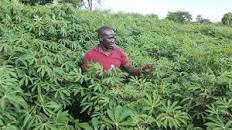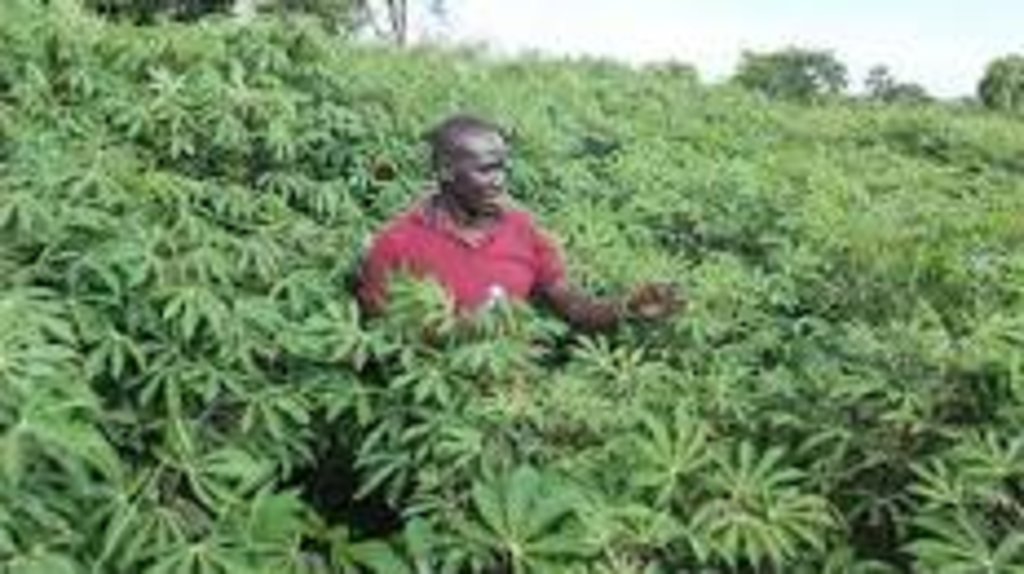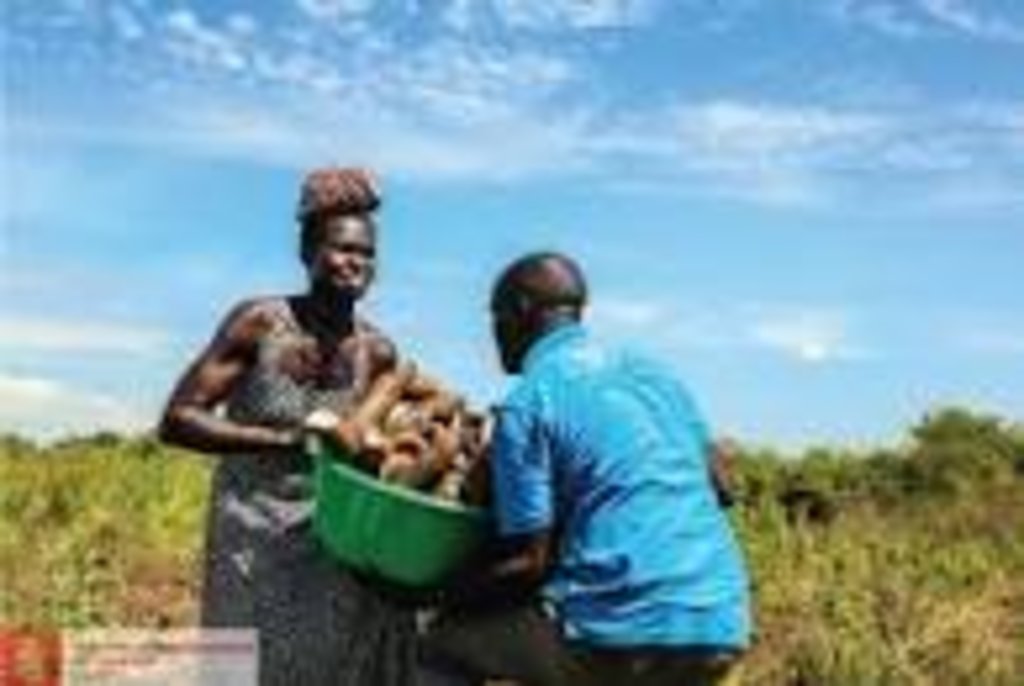CROP ROTATION OF CASSAVA AND SOY BEAN [Uganda]
- Creation:
- Update:
- Compiler: betty adoch
- Editors: JOY TUKAHIRWA, Kamugisha Rick Nelson
- Reviewer: Udo Höggel
leno cam i poto
technologies_2699 - Uganda
View sections
Expand all Collapse all1. General information
1.2 Contact details of resource persons and institutions involved in the assessment and documentation of the Technology
Key resource person(s)
land user:
Olal Levi
Agago District Local Government
Kazikazi parish, Arum village.
Uganda
Name of project which facilitated the documentation/ evaluation of the Technology (if relevant)
Scaling-up SLM practices by smallholder farmers (IFAD)Name of the institution(s) which facilitated the documentation/ evaluation of the Technology (if relevant)
CDE Centre for Development and Environment (CDE Centre for Development and Environment) - Switzerland1.3 Conditions regarding the use of data documented through WOCAT
When were the data compiled (in the field)?
10/05/2017
The compiler and key resource person(s) accept the conditions regarding the use of data documented through WOCAT:
Yes
1.4 Declaration on sustainability of the described Technology
Is the Technology described here problematic with regard to land degradation, so that it cannot be declared a sustainable land management technology?
No
Comments:
Crop rotation enhance soil fertility since different plant consume different plant nutrients.
2. Description of the SLM Technology
2.1 Short description of the Technology
Definition of the Technology:
The improved variety of cassava known as Nafe14 is grown on a gentle slope. Animal traction was used to plough 43 acres of land. The land was initially used for growing soya beans. The cassava garden has some trenches dug across so to control flooding and soil erosion. By this a high moisture content is retained in the soil. This cassava species is drought resistant.
2.2 Detailed description of the Technology
Description:
Crop rotation is the growing of different crops in the same piece of land year after year. This land user grows Cassava (Manihota esculenta) and Soy beans (Glycine max). in the field. The improved cassava variety (Nafe 14) was planted in 2015 on 43 acres during rainy season. The planting hole was dug 6 inches (square) in length and 6 to 10 inches depth, spaced at one meter distance.
The cassava stem is cut at 6 inch length and the planting may be done immediately as the holes are dug. If the area has termites then it should rain into the planting hole and later should stay for two days after which planting should be done. This is because the rain should seal the termites traces in order to protect the cassava stem from being destroyed by termites. Cassava growing protects the soil from erosion, is a source of income and protects land from wrangles.
Weeding is constantly done to control weed and to promote high yields.
2.3 Photos of the Technology
2.4 Videos of the Technology
Date:
10/05/2017
Location:
Agago District
Name of videographer:
Betty Adoch
2.5 Country/ region/ locations where the Technology has been applied and which are covered by this assessment
Country:
Uganda
Region/ State/ Province:
Northern Uganda
Further specification of location:
Agago Town council
2.6 Date of implementation
Indicate year of implementation:
2015
2.7 Introduction of the Technology
Specify how the Technology was introduced:
- through land users' innovation
Comments (type of project, etc.):
The land user obtained the cassava stems from Agago District Local Government which, again was being supplied by Operation Wealth Creation.
3. Classification of the SLM Technology
3.1 Main purpose(s) of the Technology
- improve production
- reduce, prevent, restore land degradation
- preserve/ improve biodiversity
- reduce risk of disasters
- adapt to climate change/ extremes and its impacts
- create beneficial economic impact
- create beneficial social impact
3.2 Current land use type(s) where the Technology is applied

Cropland
- Annual cropping
Main crops (cash and food crops):
Cassava
3.3 Further information about land use
Water supply for the land on which the Technology is applied:
- rainfed
Comments:
There is need for irrigation during dry season.
Number of growing seasons per year:
- 1
3.4 SLM group to which the Technology belongs
- rotational systems (crop rotation, fallows, shifting cultivation)
3.5 Spread of the Technology
Specify the spread of the Technology:
- evenly spread over an area
If the Technology is evenly spread over an area, indicate approximate area covered:
- < 0.1 km2 (10 ha)
Comments:
cassava growing is sustainable in terms of soil conservation.
3.6 SLM measures comprising the Technology

agronomic measures
- A1: Vegetation/ soil cover
- A2: Organic matter/ soil fertility
- A5: Seed management, improved varieties
3.7 Main types of land degradation addressed by the Technology

soil erosion by water
- Wt: loss of topsoil/ surface erosion
- Wo: offsite degradation effects

soil erosion by wind
- Et: loss of topsoil
- Eo: offsite degradation effects

biological degradation
- Bc: reduction of vegetation cover
- Bh: loss of habitats
- Bs: quality and species composition/ diversity decline
- Bl: loss of soil life
Comments:
The methods protects the soil from both human-induced- and natural causes of degradation.
3.8 Prevention, reduction, or restoration of land degradation
Specify the goal of the Technology with regard to land degradation:
- prevent land degradation
- reduce land degradation
Comments:
The mentods conserves soil moisture and nutrients.
4. Technical specifications, implementation activities, inputs, and costs
4.1 Technical drawing of the Technology
4.2 Technical specifications/ explanations of technical drawing
The improved cassava variety (Nafe 14) was planted in 2015 on 43 acres during rainy season. The planting hole was dug 6 inches (square) in length and 6 to 10 inches depth, spaced at one meter distance.
4.3 General information regarding the calculation of inputs and costs
Specify how costs and inputs were calculated:
- per Technology area
Indicate size and area unit:
43 acres
other/ national currency (specify):
UGX
Indicate exchange rate from USD to local currency (if relevant): 1 USD =:
3500.0
Indicate average wage cost of hired labour per day:
3000shs
4.4 Establishment activities
| Activity | Type of measure | Timing | |
|---|---|---|---|
| 1. | Acquiring cassava stems from Operation Wealth Creation | Agronomic | dry season |
| 2. | Clearing the land by tractor | Agronomic | onset of rainy season |
| 3. | Planting using hired labour | Agronomic | rainy season |
4.5 Costs and inputs needed for establishment
| Specify input | Unit | Quantity | Costs per Unit | Total costs per input | % of costs borne by land users | |
|---|---|---|---|---|---|---|
| Labour | Hired labour | acres | 43.0 | 48000.0 | 2064000.0 | 100.0 |
| Equipment | Tractor for ploughing | hours | 48.0 | 20000.0 | 960000.0 | 100.0 |
| Equipment | Ox-plough | hours | 48.0 | 20000.0 | 960000.0 | 100.0 |
| Equipment | Axes | piece | 10.0 | 7000.0 | 70000.0 | 100.0 |
| Equipment | Hoes | piece | 20.0 | 12000.0 | 240000.0 | 100.0 |
| Plant material | Cassava cuttings | acres | 43.0 | 20000.0 | 860000.0 | 100.0 |
| Total costs for establishment of the Technology | 5154000.0 | |||||
Comments:
Cassava cuttings were provided free of charge by the local government.
4.6 Maintenance/ recurrent activities
| Activity | Type of measure | Timing/ frequency | |
|---|---|---|---|
| 1. | Weeding | Agronomic | wet season |
| 2. | Fire line | Agronomic | dry season |
Comments:
Fire out breaks during dry season may destroy cassava gardens
4.7 Costs and inputs needed for maintenance/ recurrent activities (per year)
| Specify input | Unit | Quantity | Costs per Unit | Total costs per input | % of costs borne by land users | |
|---|---|---|---|---|---|---|
| Labour | Weeding | acre | 43.0 | 2500.0 | 107500.0 | 100.0 |
| Equipment | Hoes | piece | 60.0 | 12000.0 | 720000.0 | 100.0 |
| Equipment | Pangas | piece | 60.0 | 7000.0 | 420000.0 | 100.0 |
| Total costs for maintenance of the Technology | 1247500.0 | |||||
Comments:
The land user has adequate capital to invest in cassava growing.
5. Natural and human environment
5.1 Climate
Annual rainfall
- < 250 mm
- 251-500 mm
- 501-750 mm
- 751-1,000 mm
- 1,001-1,500 mm
- 1,501-2,000 mm
- 2,001-3,000 mm
- 3,001-4,000 mm
- > 4,000 mm
Specify average annual rainfall (if known), in mm:
950.00
Specifications/ comments on rainfall:
Rainfall is moderate and unreliable during wet season in the months of April, May, June, July, August, September and October. Whereas November, December, January, Feburary and March it is dry season and there is little or no rainfall at all.
Indicate the name of the reference meteorological station considered:
Kitgum Weather Station
Agro-climatic zone
- sub-humid
Savanna climate where rainfall is moderate and unreliable during wet season.
5.2 Topography
Slopes on average:
- flat (0-2%)
- gentle (3-5%)
- moderate (6-10%)
- rolling (11-15%)
- hilly (16-30%)
- steep (31-60%)
- very steep (>60%)
Landforms:
- plateau/plains
- ridges
- mountain slopes
- hill slopes
- footslopes
- valley floors
Altitudinal zone:
- 0-100 m a.s.l.
- 101-500 m a.s.l.
- 501-1,000 m a.s.l.
- 1,001-1,500 m a.s.l.
- 1,501-2,000 m a.s.l.
- 2,001-2,500 m a.s.l.
- 2,501-3,000 m a.s.l.
- 3,001-4,000 m a.s.l.
- > 4,000 m a.s.l.
Indicate if the Technology is specifically applied in:
- not relevant
5.3 Soils
Soil depth on average:
- very shallow (0-20 cm)
- shallow (21-50 cm)
- moderately deep (51-80 cm)
- deep (81-120 cm)
- very deep (> 120 cm)
Soil texture (topsoil):
- medium (loamy, silty)
Soil texture (> 20 cm below surface):
- medium (loamy, silty)
Topsoil organic matter:
- medium (1-3%)
5.4 Water availability and quality
Ground water table:
5-50 m
Availability of surface water:
good
Water quality (untreated):
poor drinking water (treatment required)
Is water salinity a problem?
Yes
Specify:
salty and rusty borehole
Is flooding of the area occurring?
No
5.5 Biodiversity
Species diversity:
- high
Habitat diversity:
- high
Comments and further specifications on biodiversity:
Wild rats, birds all coexist in the garden.
5.6 Characteristics of land users applying the Technology
Sedentary or nomadic:
- Sedentary
Market orientation of production system:
- subsistence (self-supply)
Off-farm income:
- 10-50% of all income
Relative level of wealth:
- average
Individuals or groups:
- individual/ household
Level of mechanization:
- animal traction
- mechanized/ motorized
Gender:
- women
- men
Age of land users:
- middle-aged
- elderly
Indicate other relevant characteristics of the land users:
The land user owns 80 cattle, goats, chickens and turkeys.
5.7 Average area of land owned or leased by land users applying the Technology
- < 0.5 ha
- 0.5-1 ha
- 1-2 ha
- 2-5 ha
- 5-15 ha
- 15-50 ha
- 50-100 ha
- 100-500 ha
- 500-1,000 ha
- 1,000-10,000 ha
- > 10,000 ha
Is this considered small-, medium- or large-scale (referring to local context)?
- small-scale
Comments:
The land is fertile and supports cassava growing.
5.8 Land ownership, land use rights, and water use rights
Land ownership:
- individual, not titled
Land use rights:
- individual
Water use rights:
- communal (organized)
Comments:
The land owner should acquire land title to reduce land related conflicts.
5.9 Access to services and infrastructure
health:
- poor
- moderate
- good
education:
- poor
- moderate
- good
technical assistance:
- poor
- moderate
- good
employment (e.g. off-farm):
- poor
- moderate
- good
markets:
- poor
- moderate
- good
energy:
- poor
- moderate
- good
roads and transport:
- poor
- moderate
- good
drinking water and sanitation:
- poor
- moderate
- good
financial services:
- poor
- moderate
- good
6. Impacts and concluding statements
6.1 On-site impacts the Technology has shown
Socio-economic impacts
Production
crop production
Quantity before SLM:
low
Quantity after SLM:
high
Comments/ specify:
Improved variety planted.
crop quality
Quantity before SLM:
Low
Quantity after SLM:
High
Comments/ specify:
High yielding cassava Nafe14 variety is used.
Income and costs
expenses on agricultural inputs
Quantity before SLM:
low
Quantity after SLM:
high
Comments/ specify:
Cassava plantation requires less labor force after planting.
farm income
Quantity before SLM:
low
Quantity after SLM:
high
Comments/ specify:
Has greatly increased income generation.
diversity of income sources
Quantity before SLM:
low
Quantity after SLM:
high
Comments/ specify:
The farmer has other sources of income from cassava growing.
economic disparities
Quantity before SLM:
high
Quantity after SLM:
low
Comments/ specify:
The land user has assured source of income.
Socio-cultural impacts
food security/ self-sufficiency
Quantity before SLM:
low
Quantity after SLM:
high
Comments/ specify:
Cassava provides constant food supply to the land user.
SLM/ land degradation knowledge
Quantity before SLM:
low
Quantity after SLM:
high
Comments/ specify:
The farmer has learned about the importance crop rotation.
Ecological impacts
Soil
soil moisture
Quantity before SLM:
low
Quantity after SLM:
high
Comments/ specify:
The cassava plants reduces the rate of evaporation.
soil cover
Quantity before SLM:
low
Quantity after SLM:
high
Comments/ specify:
Cassava plant protects the soil from erosion and provides habitat to a variety of different plant species.
Biodiversity: vegetation, animals
Vegetation cover
Quantity before SLM:
low
Quantity after SLM:
high
Comments/ specify:
Variety of plant species exist in the garden.
plant diversity
Quantity before SLM:
low
Quantity after SLM:
high
Comments/ specify:
Cassava and other plant species exist.
6.3 Exposure and sensitivity of the Technology to gradual climate change and climate-related extremes/ disasters (as perceived by land users)
Gradual climate change
Gradual climate change
| Season | Type of climatic change/ extreme | How does the Technology cope with it? | |
|---|---|---|---|
| annual temperature | increase | moderately | |
| seasonal temperature | dry season | increase | moderately |
| annual rainfall | decrease | moderately | |
| seasonal rainfall | wet/ rainy season | decrease | moderately |
Climate-related extremes (disasters)
Meteorological disasters
| How does the Technology cope with it? | |
|---|---|
| local rainstorm | moderately |
| local thunderstorm | moderately |
| local hailstorm | moderately |
| local windstorm | moderately |
Climatological disasters
| How does the Technology cope with it? | |
|---|---|
| drought | moderately |
Biological disasters
| How does the Technology cope with it? | |
|---|---|
| epidemic diseases | moderately |
| insect/ worm infestation | moderately |
Comments:
Cassava growing is a sustainable land management practice.
6.4 Cost-benefit analysis
How do the benefits compare with the establishment costs (from land users’ perspective)?
Short-term returns:
slightly positive
Long-term returns:
positive
How do the benefits compare with the maintenance/ recurrent costs (from land users' perspective)?
Short-term returns:
slightly positive
Long-term returns:
positive
Comments:
Cassava has high demand due to hunger facing the communities.
6.5 Adoption of the Technology
- 1-10%
If available, quantify (no. of households and/ or area covered):
15 households
Of all those who have adopted the Technology, how many have did so spontaneously, i.e. without receiving any material incentives/ payments?
- 90-100%
Comments:
Cassava growing is a traditional way of earning income and provide food to the family.
6.6 Adaptation
Has the Technology been modified recently to adapt to changing conditions?
Yes
If yes, indicate to which changing conditions it was adapted:
- changing markets
Specify adaptation of the Technology (design, material/ species, etc.):
Improved high yielding cassava variety planted to earn income.
6.7 Strengths/ advantages/ opportunities of the Technology
| Strengths/ advantages/ opportunities in the land user’s view |
|---|
| Very good at providing income after selling cassava and soya bean |
| Very easy to replicate |
| Strengths/ advantages/ opportunities in the compiler’s or other key resource person’s view |
|---|
| Source of employment for both small, medium and large scale farmers. |
6.8 Weaknesses/ disadvantages/ risks of the Technology and ways of overcoming them
| Weaknesses/ disadvantages/ risks in the land user’s view | How can they be overcome? |
|---|---|
| Invites thieves during hunger period | Tight security in the garden |
| The variety take long to mature | |
| Cassava is prone to disease | Spraying with herbicide |
| Weaknesses/ disadvantages/ risks in the compiler’s or other key resource person’s view | How can they be overcome? |
|---|---|
| Expensive to establish and maintain the garden | Employing low costs labour |
7. References and links
7.1 Methods/ sources of information
- field visits, field surveys
01
- interviews with land users
01
7.2 References to available publications
Title, author, year, ISBN:
Intercropping and crop rotations in cassava cultivation: a production systems approachThomas W. Kuyper, Wageningen University, The Netherlands; and Samuel Adjei-Nsiah,
7.3 Links to relevant information which is available online
Title/ description:
Field stability of cassava, maize, soya bean and cowpea intercrops DAPAAH, H K; ASAFU-AGYEI, J N; ENNIN, S A; YAMOAH, C. The Journal of Agricultural Science; Cambridge Vol. 140, Iss. 1, (Feb 2003): 73-82.
URL:
https://www.proquest.com/docview/203707559
Links and modules
Expand all Collapse allLinks
No links
Modules
No modules






